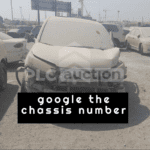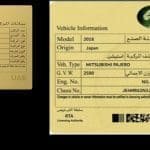

How to Inspect a Used Car Before Buying in Abu Dhabi
How to Inspect a Used Car Before Buying in Abu Dhabi
When looking to buy a used car, one of the most important steps is knowing how to inspect a used car before buying. Many buyers may feel overwhelmed or uncertain about where to begin. However, by following a structured approach, you can make sure you are getting the best value for your money. This post will guide you through the inspection process and highlight the key things to look for, ensuring that you avoid any surprises after the purchase.
Inspect the Exterior of the Car
The first thing you need to check when inspecting a used car is its exterior. Walk around the car and assess the condition of the bodywork. Look for any noticeable scratches, dents, or rust spots. Pay close attention to the areas where rust is most likely to form, such as around the wheel arches, under the doors, and along the side skirts. These might be signs that the car has been exposed to harsh conditions, or worse, that it might have been involved in an accident.
It’s also essential to inspect the paintwork. Make sure the color is consistent across the entire car. If you notice differences in shade or texture, it could indicate that the car has been repainted after repairs. While minor cosmetic issues are normal in used cars, major discrepancies in the bodywork may be a red flag.
Check the alignment of the car doors and windows. If they do not open or close smoothly, it could be a sign of structural damage or issues with the vehicle’s frame.
Examine the Tires
Tires play a crucial role in your car’s safety and performance. During your inspection, take a close look at all four tires. Check for any signs of wear, including bald spots, uneven wear patterns, or cuts in the rubber. Uneven tire wear may indicate suspension or alignment issues.
Ensure the tires are of the correct size and brand for the vehicle. If the tires are mismatched, it could be a sign of neglect or cost-cutting by previous owners. Don’t forget to check the tread depth using a tread gauge. Tires with insufficient tread depth need to be replaced, which can be an added expense.
Check the Engine and Transmission
Under the hood is where you’ll find the engine and transmission, both critical components of any vehicle. Begin by checking the engine for any signs of leaks or corrosion. Look for any oil stains or coolant leaks. A well-maintained engine should not have excessive oil leaks, as this could signal a potential problem.
Next, check the level and condition of the engine oil. Clean, amber-colored oil indicates good maintenance. Dark, dirty oil could be a sign that the car hasn’t been properly maintained, which could lead to engine issues down the line.
Inspect the radiator and hoses for any visible cracks or leaks. Ensure the belts are not worn out and that the engine is running smoothly. If the car makes strange noises or the engine seems to be struggling, it could be a sign of underlying issues.
Check the transmission by putting the car into different gears and observing how it responds. A smooth shift between gears indicates that the transmission is in good condition. If the car hesitates, grinds, or makes unusual noises, it may have a transmission problem.
Test the Interior Features
Next, focus on the interior of the vehicle. The condition of the car’s interior can tell you a lot about how well it has been cared for. Start by inspecting the seats, dashboard, and steering wheel for any signs of excessive wear. Are the seats comfortable and intact, or do they have rips, stains, or other damages? Pay attention to the condition of the upholstery, especially in the areas where the car is most often used.
Test all of the car’s electrical features, including the lights, air conditioning, radio, windows, and mirrors. Make sure everything works as expected. If the air conditioning blows warm air or the windows are slow to open and close, it could indicate a potential electrical problem. It’s important to check these features before finalizing the deal.
Don’t forget to check the car’s odometer. Compare the mileage to the condition of the vehicle. A car with low mileage might look appealing, but if it’s too low for the car’s age, it could indicate that the vehicle hasn’t been driven regularly. This may cause issues with the engine and other systems.
Inspect the Undercarriage
The undercarriage is another crucial part of the car to inspect. While it can be difficult to access, it is worth the effort. Use a flashlight and crawl under the vehicle to check for rust, oil leaks, or any signs of damage to the frame. Pay attention to the exhaust system, as it can sometimes have holes or other problems that might not be immediately visible from above.
Look at the suspension system, which includes shocks and struts. Worn-out suspension parts can cause handling issues and affect the overall driving experience. If you notice any damage, this could be a costly repair down the road.
Take the Car for a Test Drive
Once you have visually inspected the car, the next step is to take it for a test drive. This is an essential part of the inspection process and allows you to assess the vehicle’s performance. Pay attention to how the car drives and whether you notice any strange noises, vibrations, or smells.
During the test drive, check the brakes. A properly functioning brake system should feel firm and responsive. If the brakes feel spongy or make a grinding sound, they might need to be repaired or replaced. Additionally, make sure the steering wheel aligns properly when driving straight. If it pulls to one side, the alignment may be off.
Drive the car on different types of roads to get a feel for how it handles. This will give you an opportunity to test the suspension, the noise levels, and the comfort of the ride.
Review the Car’s History
Before making any final decisions, it’s important to review the car’s history. Ask the seller for maintenance records, accident reports, and any other relevant documentation. A well-maintained car will have a clear history of regular servicing, and you should be able to verify that the car has not been in any serious accidents.
You can also check the vehicle’s history using services that provide detailed reports on the car’s past. This can help you find out whether the car has been involved in a major accident or if it has a salvage title, which could indicate that it was previously written off by an insurance company.
Have a Professional Inspection Done
If you’re unsure about performing a thorough inspection on your own, consider hiring a professional mechanic to do it for you. A mechanic will be able to identify any hidden issues that might not be obvious during a visual inspection. This step can provide peace of mind and ensure that you are making a sound investment.
While some buyers may feel confident in inspecting the car themselves, a professional mechanic will bring the expertise and equipment needed to spot potential problems. They will also be able to provide an honest assessment of the car’s condition and whether it’s worth the asking price.
Final Thoughts
Knowing how to inspect a used car before buying is a valuable skill that every car buyer should master. By paying attention to the exterior, interior, engine, and other important components, you can make an informed decision and avoid buying a car that will cost you more money in repairs later on. Always take your time, perform a thorough inspection, and never hesitate to ask for professional help when needed. Whether you’re looking to sell your car or buy a new one, being diligent in your inspection will ensure that you’re getting the best deal possible.
What should I look for when inspecting a used car in Abu Dhabi?
When inspecting a used car in Abu Dhabi, you should check for signs of wear and tear on the body, tires, and interior. Look for any rust, scratches, or dents on the exterior. Additionally, inspect the engine for leaks, test the car’s brakes, and ensure that all interior features, such as the air conditioning, are functioning properly.
How can I tell if a used car has been in an accident in Abu Dhabi?
To determine if a used car has been in an accident, check the bodywork for uneven paint, misaligned doors, or any signs of previous repairs. You can also request the vehicle’s history report, which will highlight any accidents or incidents the car may have been involved in.
What are the signs of a good used car deal near me in Abu Dhabi?
A good used car deal in Abu Dhabi should have a clear history of regular maintenance, no major accidents, and reasonable pricing based on the market value. The car should be in good condition, both mechanically and visually. Make sure to ask for maintenance records and check the mileage against the vehicle’s condition.
How important is it to have a professional inspection before buying a used car in Abu Dhabi?
A professional inspection is highly recommended when buying a used car in Abu Dhabi. It helps to identify hidden issues that you may not notice during a regular inspection. A mechanic will provide a detailed report on the car’s condition, helping you avoid unexpected repair costs down the line.
Is it worth buying a used car from a dealership in Abu Dhabi?
Buying a used car from a dealership in Abu Dhabi can offer several benefits, including warranty options, certified inspections, and easier financing options. Dealerships may also provide a more transparent history of the car. However, it’s important to still perform your own inspection or have a professional mechanic check the vehicle.
Sell any car cash todayCheck our frequently asked questions page
Add a comment Cancel reply
Categories
- Abu Dhabi (2)
- Accidents (3)
- Car Registration (1)
- GCC Specs (3)
- Imported (3)
- Sell a car (1)
- Specs (1)
- Uncategorized (11,310)
Recent Posts
Related posts


Trusted Used Car Buyer in Umm Al Quwain

How to Sell a Car in Umm Al Quwain Easily










